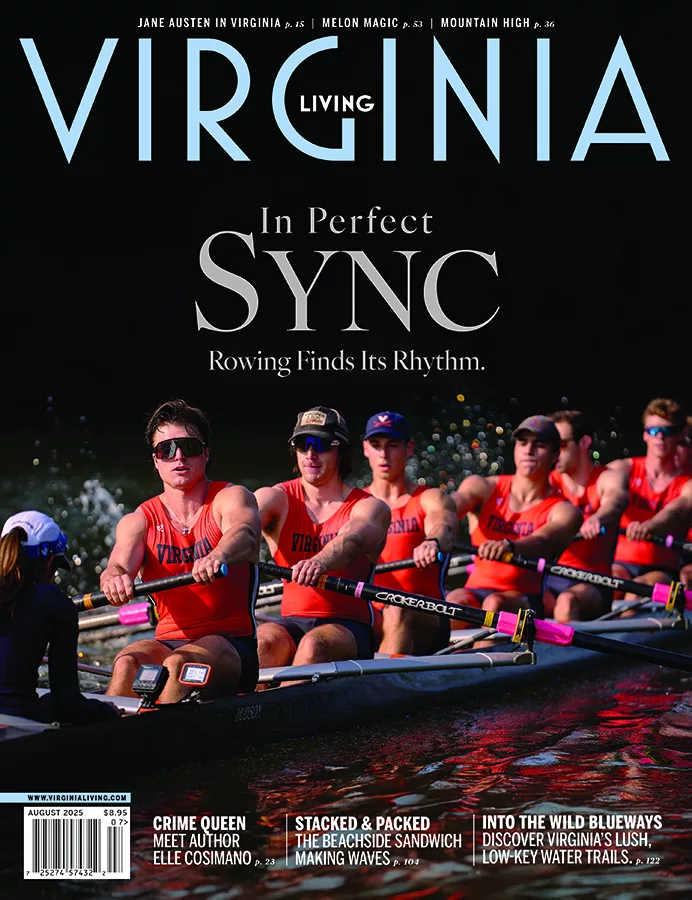Clarke C. Jones travels to the picturesque Rose River and meets some long-time anglers who show him why fly fishing isn’t just about catching fish.

Billy Pearsall fishing on the Rose River.

Limited entry and exit points to and from the river protect the steep banks from erosion.

Ken Eastwood, Dear, Gary Burwell and Cox.

Douglas Dear.

Rose River Farm in Syria.

Andy Cox prepares his fly rod.

Trout feed on bugs that float downstream.

Cox’s handmade flies.

Eastwood.

Bird’s-eye view of the Rose River.

Burwell watches as Cox casts his line.

Cox and Pearsall.

A trout that will be released.

Burwell.

Eastwood fishing near a small dam.

Colby and Brian Trow.

Under the stars at Rose River Farm.
Photography by Jeff Greenough
On a warm, late September morning, I headed up the scenic Old Blue Ridge Turnpike, passing through the little hamlets of Banco and Criglersville on my way to Rose River Farm, a private fly fishing destination near Syria in Madison County. Rose River Farm is owned by Douglas Dear, 46, a retired commercial mortgage banker through whose property runs a portion of the Rose River, one of the prettiest trout streams in Virginia. I was meeting Dear and three other fishing partners from Richmond who have among them over 100 years of fly-fishing experience. I knew that for the fly fisherman, especially my companions who fish for trout, fishing is not just about catching fish. I had come to find out why.
After I turned left off Route 670 to cross a single-lane bridge over the river which leads to the farm, I stopped on the bridge and looked down at the rushing waters and had to grin. The Rose looked and sounded just as I imagined the perfect trout stream should. With its small, cascading waterfalls and its quiet pools—holding what I hoped would be an abundance of large rainbow trout—I could see why people who had been here before me smiled wistfully when I told them where I was headed.
Waiting for me on the banks of the Rose were Dear and the farm’s fishing guide, Gary Burwell, along with my fishing partners—Ken Eastwood, Andy Cox and Billy Pearsall. They had been lured by the prospect of catching some of the stream’s beautiful large rainbows, though Dear’s portion of the Rose is a “catch and release” stream, so any fish we caught would be going back into the water. Having assembled rods and reels and put on fishing boots, chest waders and fly-fishing vests, we were eager to start fishing.
Rather than using live bait to attract the trout, fly fishermen use artificial flies that have been painstakingly hand-crafted to resemble insects and other natural food sources. The challenge is not just to read the water for clues to the trout’s whereabouts, but also to carefully select the fly that most resembles what the fish are eating that day.
“When I got to the Rose this morning, I observed mayfly nymphs under the rocks in the river,” said Eastwood, who is currently president of the Fly Fishers of Virginia, a 30 year-old Richmond-based nonprofit organization that promotes fly fishing. Eastwood had decided to fish with a fly that replicates the nymphal stage of the mayfly—a #18 Hare’s Ear Nymph, a relatively small fly made of chopped fur or synthetic material wrapped around the shank of the hook. “It’s the ‘buggy’ looking phase of the mayfly,” Eastwood explained. Mayflies or caddisflies rising from the water may have only 24 hours of life. In that time they mate, lay their eggs and die. “Not only is a hatch coming off the water a beautiful thing to see,” observed Pearsall, a past president of the Fly Fishers of Virginia, “watching it causes you to reflect a little on what is really important in your life.”
While many fly fishermen enjoy the camaraderie of fellow fishermen, one of the great contradictions of trout fishing is that when everyone takes to the water, quite often they seek their own space—out of sight of their fishing buddies. Eastwood moved to a spot the farthest upstream, where the water narrows a bit and the growth along the bank makes casting a little more challenging. While I would have snagged a branch or limb on every back cast, I watched as he expertly put the fly just about anywhere he wanted it to go. Cox ventured downstream to where the river became wider and deeper to fish two shaded pools.
Even further downstream, Pearsall was stripping his line—retrieving the line by pulling it in through his fingers as opposed to winding it in on the reel—and sending it upstream, making sure to keep the line tight in case a fish should strike. Fly fishermen, he told me, normally try to fish upstream because the silt they disturb under their feet will float downstream. Instinctively, the fish can tell when something other than clear water is coming towards them, and even the slightest change in their environment might make them move elsewhere. Plus, as Burwell told me, trout, like any natural predator, are opportunists and “typically sit on the current seams where the faster water joins the slower moving water. This allows the fish to feed on bugs floating downstream without exerting too much energy to stay in place.”
It wasn’t long before Pearsall had a strike. He missed it, and then the fish struck again. Pearsall’s rod hand snapped skyward keeping tension on the line as the fish shot to the far bank trying to find a way to dislodge the hook—which it did—and then headed downstream. Pearsall, with a somewhat resigned look on his face, merely examined the fly, saw that it was still in good shape and sent it out again. Moments later he had another strike from a fish that looked bigger than the one that got away. As Pearsall brought the fish to him, he switched the rod into his other hand and reached back to unclip the landing net attached to the back of his fishing vest. Seeing the net coming towards him, the fish seemed to find some extra energy and tried to make an escape. But Pearsall had done this many times before and neatly slid the net under the fish. Then, tucking the rod under his arm to hold it, and keeping the fish in the water and the net at the same time, he reached in his vest, pulled out a pair of forceps and gently removed the hook.
One of the things that impresses me most about fly fishermen who have a catch and release mindset is how much concern they have over the creature they have just caught. As Pearsall released the hook from the fish, he tilted the net forward and watched the fish swim away. If the fish could not have swum off on its own power, Pearsall would have gently moved the fish back and forth, making sure water was flowing through its gills until it could.
That is one of the paradoxes of fly fishing. A fly fisherman or woman will spend hours perfecting different types of casts, then attach a fly that they spent many more hours learning to make while hunched over a small vise, trying to replicate a small insect often no bigger than an ant, using feathers, glue, string, glitter and/or animal fur. He hopes he has imitated the insect well enough so when he presents it to the fish, that particular fish is eating that particular bug on that particular day and will accept the hand-crafted bug over the real thing. If that is not enough, the trout fisher ties a tiny fly to a hair-thin line, which might break if too much pressure is exerted on it. The fisherman may drive hours to a trout stream he has waited weeks to visit and then hope against hope that some other fly fisher is not standing right where he wants to fish. If there is any wind, it could be blowing in the wrong direction, making casting a fly, which weighs no more than a turkey feather, extremely difficult. Ever try to throw a turkey feather 60 feet? He will do this all day, only stopping to change to a different fly pattern, thinking that the new pattern is the right one. Just as he is ready to give it all up, he catches a 9-inch trout. He brings the trout to the net, admires it for a few moments and then releases it. On his trip home, he will think it has been a fine day.
“Trout fishing, to me, is not about the number of fish caught. It is about being on the water, hearing it, seeing it and seeing all the things that come with it,” said Pearsall. “With everything there is to enjoy about the day, catching a fish is just icing on the cake.”
Later that night, we built a fire in the fire pit on the terrace of one of the two modern cabins at Rose River Farm (which is conveniently equipped with a fly-tying table and vise). As we sat watching the fire warm the darkness, we talked about what all fly fishermen talk about: fly fishing. “I think,” Cox remarked as we all took in the relaxing night, “that people make the mistake of making fly fishing too precious. They go out and buy the most expensive rod-and-reel set and think that will make them a better fly fisher. A fish doesn’t know if you are using a $100 rod-and-reel set or a $1,000 set.”
Sounded like smart thinking to me. I mentioned to the group that, for my next fly fishing trip, I wanted to find a place where I could catch brook trout, Virginia’s only true native trout. Technically, brook trout are not really trout but char; but if Virginians want to pronounce Staunton as Stand-ton, we can darn well call a char a trout. Virginia’s brook trout are normally found in mountain streams and western spring creeks where waters remain cooler. There are more than 2,800 miles of fishable trout streams in Virginia; of those streams, over 2,300 miles are wild, and 600 miles are stocked like Rose River Farm. Pearsall, who likes to fish the mountain streams, recommended I visit Harrisonburg and meet the Trows, twin brothers who own Mossy Creek Outfitters, a fly-fishing shop and guide service. “There are probably no two individuals who know more about trout fishing in Virginia than the Trows,” explained Pearsall. “They know their streams and the flies that work in them; they know where the conditions are best and will tell you when they are not; and, most importantly, they know where the fish should be.”
Two weeks later, I was in Harrisonburg, introducing myself to the 32-year-old brothers, Brian and Colby Trow. Growing up in Richmond, they were bitten by the fishing bug around age eight, after Colby took a fly-fishing lesson at Wintergreen. “Our neighbor at the time, Carl Fischer, who was president of Trout Unlimited and a past president of Fly Fishers of Virginia, took us under his wing and taught us how to tie flies,” Colby told me. Another gentleman, Nat Burgwyn, became their mentor and he, along with other members of the FFV, would take them on fly-fishing trips. By the time they were in the 8th grade, they were selling their flies to fly fishing shops in Virginia. “Thanks to Nat, we were allowed to go to the FFV meeting and, at age 14, were the first junior members allowed in the club,” said Brian. The brothers even attended James Madison University, in part, because of the quantity of good trout streams in the area.
After graduation, Brian, having earned a Bachelor of Science in geology, and Colby, a degree in biology, accepted jobs in Northern Virginia, but they were soon offered an opportunity to move back to the Harrisonburg area. The result? At age 23, they opened their own fly and tackle shop in Harrisonburg. “It was slow at first because here we were, a couple of very young guys, running a fly shop and guiding fishing trips. Customers or vendors would come in and want to speak to the owner, and we said, ‘You are.’ It was kind of hard for people who had been fly fishing longer than we had been alive to trust us,” Brian told me with an understanding smile. “But they soon realized that one or the other of us was on trout streams every day, whereas the client may see a stream three times a year. Soon, they began to see that it paid to listen to this young kid, because we knew every inch of the stream we were fishing.”
Mossy Creek Outfitters is located in the heart of Harrisonburg near the intersection of Route 33 and University Boulevard. A small shop, it carries most of the major brands of fly gear and fly tying supplies. But the most popular item in the store is not the fly fishing gear—it is the brothers’ fly-fishing knowledge. The other asset the Trow brothers have is something they worked very hard for, and that is private access to a number of the spring creeks in the area.
There are many spring creeks with fish within an hour’s drive of Harrisonburg, but a great many of them run through private property. The Trow brothers have formed an alliance, so to speak, with many of the farmers and other property owners. By educating local landowners about the benefits from government programs like the Conservation Reserve Enhancement Program (CREP), which assists with fencing for grazing animals and watershed protection measures, they are working to ensure the quality of fishing waters in the area. They are members of the Shenandoah Riverkeeper Association and board members of the local Trout Unlimited chapter.
A business is built on its reputation, and the Trows have worked diligently to enhance theirs by doing the extra things. Seth Coffman, Project Coordinator for the Shenandoah Headwaters Home Rivers Initiative for Trout Unlimited, explained, “We are in the initial stages of a dam removal and a 2,000-foot stream restoration project on Mossy Creek that got started due, in large part, to Brian and Colby’s outreach efforts with landowners on Mossy Creek. They understand the responsibility that comes with the privilege of having access to these waters.”
Although fly fishing is their business, both brothers understand there is a line they must walk as businessmen and environmentalists. “We offer a product that fly fishermen want, but we refuse to put too much pressure on a stream,” Colby told me, noting that one of the distinct advantages of fly fishing in Virginia is the climate: You can fish Virginia streams all year long. For trout to succeed, they need a sustained flow of water at a sustained temperature range between 33 and 70 degrees. “Sixty-two degrees is when trout are most active,” explained Brian. “All the ground water around the Harrisonburg and Luray areas is 55 degrees, so trout in these streams are growing mostly year round,” unlike fishing out west, say, on the Madison River in Montana, where trout normally only grow four to five months of the year.
“Fly fishing is a sport; fly tying is an art,” Colby emphasized. “It is one of the few sports that combine both. You don’t have to be a fisherman to enjoy the art, although many do.”
Yes, fly fishing is a lot of things, but I think that Pearsall said it best when we were relaxing around the fire that night on the Rose River: “Fly fishing can be as simple or as complex as you want it to be. You will always find something new to learn or see. It is probably the only sport where you can find yourself or lose yourself at the same time.” •









